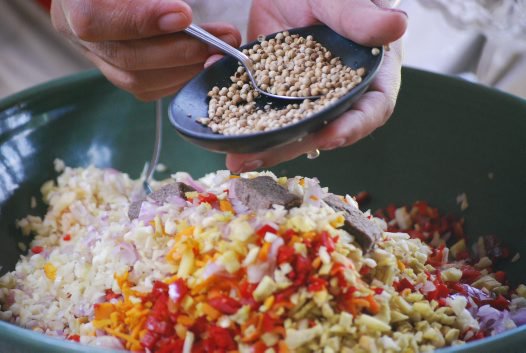For Arts Sake! – Visiting Bali #10
What should we eat in Bali?
You can go from restaurant to restaurant and try different dishes, such as mushroom and vegetable soup, minced chicken grilled on bamboo sticks, chicken in coconut curry, yellow sauce, vegetables in peanut sauce, coconut and snake bean salad, steamed fish in banana leaves, deep fried tempe in sweet soy sauce, or bananas boiled in palm sugar syrup. I have a better idea. How about try all of these dishes just for lunch?
I’ve signed up for the cooking class at ‘Paon’ (kitchen). This marvellous experience is offered by Puspa Wati and her husband Wayan Subawa in the village Laplapan near Ubud http://www.paon-bali.com/

© Australian Museum
The half day cooking class is not just about food, it is a much wider cultural experience, including a visit to the markets where my hosts explain the basic varieties of vegetables, fruits, spices, their properties and use in Balinese dishes. We then visit the rice fields and learn about the methods of growing and processing this supreme staple food. A welcome cocktail awaits us at the home of our entertaining and witty hosts, who then teach us about the layout of the Balinese home, the function of different buildings and spaces as well as their symbolism.
The visitors also learn about family life, enough to understand that in the traditional Balinese society essentially no one is alone. Every person belongs to a tightly linked extended family with a local temple as their wider spiritual focus. Wyam and Puspa are at ease with each other and talk openly about their relationship. The dozen of cooking students from all walks of life and different parts of the globe, listen intently and burst into occasional laughter. Wyan shares his recipe for happy family – the cardinal point is to keep the wife happy.
Before we know it, we are in the kitchen wearing aprons and dishtowels. The kitchen is a sizable yard with an old-fashioned wooden stove in the corner and a roof covering the food preparation area with long benches, gas stoves and a double sink. Also part of the kitchen is a little garden with herbs, chilli, beans, a large pounder and a roasting dish with coconut coals where we grill our minced chicken. The yard is flanked by the two dinning pavilions.
We cook many dishes at the same time with help from Puspa and her four helpers, who guide us through all aspects of food preparation; chopping vegies, frying tofu, cutting beans, mixing, mashing, pounding and flavouring. We often gather for a quick explanation and demo, before dispersing to individual tasks that are steadily rotated. The helpers are tactful, unobtrusive, always smiling and quietly fading away when not needed.
In two hours the lunch is ready. Beautifully presented, the food is served in the two dinning pavilions. We take our time to sample every single dish, including the extra chilli sauces and their flavours. We all agree that this meal easily matches the standard of the best restaurants in Ubud. In addition, we not only have the opportunity to sample such a variety of dishes but have a pretty good idea how to cook them.
Before we say goodbye we get a booklet filled with recipes. But the most important ingredient of this experience, I reflect, is the authentic friendly attitude of our hosts. So, I rate it 10 out of 10 plus a Koala stamp for good measure.
Explanation:
Tempe or tempeh is made from soy beans by fermentation which results in a more digestible and nutritional product, most commonly used in Indonesia and Southeast Asia.

